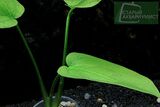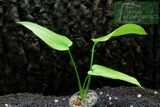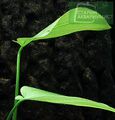Echinodorus horizontalis Rataj

Origin / Breeder : Basionym von : Aquarius horizontalis (Rataj) Christenh. & Byng
German / Trade Name : Horizontale Schwertpflanze
Echinodorus horizontalis is common in South America, the Amazon region. It is a popular amphibian plant. The leaves of the rosette are stalked. The total length of the leaves is up to 35 cm, the blade is light green, ovate, up to 20 cm long, up to 10 cm wide, the base of the leaf is heart-shaped, the tip is sharp. Heart-shaped leaves extending almost at right angles from the cuttings and almost parallel to the ground make this Echinodorus species very attractive. The height of the bush is usually 20-25 cm, but the arrangement of the leaves makes the plant wide, so a full-grown bush takes up a lot of space. It should be kept in an aquarium with a large bottom area and placed in the middle ground. Echinodorus develops evenly throughout the year. The plant is more suitable for keeping in a moderately warm aquarium at a temperature of 22 - 24 ° C. If there is a noticeable slowdown in growth, it is necessary to lower the temperature by about 20 ° C for a month and a half. Water hardness for horizontal Echinodorus does not play a major role. The active reaction of water is neutral or slightly alkaline (pH 7 - 8). Regular water changes are essential. Lighting for Echinodorus requires very strong, always top. Fluorescent lamps type LB with a power of 0.5 W per 1 liter of volume are used. In the absence of lighting Echinodorus begins to stretch upwards, the shape of the bush, for which the plant is valued, begins to change, the bright red color of young leaves fades. Daylight hours should be about 12 hours. The soil should be slightly sandy. The plant has a fairly strong root system, which spreads over a long distance, so the type of substrate is not important. It is useful to put a lump of clay under the roots of the newly planted Echinodorus. Mineral feeding is necessary because Echinodorus is very sensitive to mineral deficiency. The lack of iron is manifested in the paleness of the color of young leaves and a decrease in their size. Often the plant shows signs of nitrogen deficiency. This is usually caused by frequent water changes when cleaning the soil. Echinodorus horizontal reproduces vegetatively in an aquarium by forming daughter plants on flower shoots. On each flowering shoot, a plant appears at the very tip at the same time. After the formation of 2 leaves, the young plant must be separated from the mother and transplanted into a separate bowl of coarse sand, adding silt and clay. On the part of the flowering shoot remaining in the mother plant again appears a daughter plant, with which they do the same as with the previous one. Often the flower shoot breaks off during manipulations, then this fragment of a flower shoot with a growth bud should be left floating on the water surface. After a long time on it appears a small plant, which is also planted in a separate tray. Horizontal propagation of Echinodorus uses the seeds formed above the water. The seeds are sown in a sand tray covered with water and kept at a temperature of 26 - 28 ° C. When the seeds germinate, gradually raise the water level.[1].
-
Echinodorus horizontalis Rataj[2]
-
Echinodorus horizontalis Rataj[2]
-
Echinodorus horizontalis Rataj[2]
-
Echinodorus horizontalis Rataj[2]
- ↑ Kostiantyn Loboda, Black Water http://echinodorus.com.ua/
- ↑ 2.0 2.1 2.2 2.3 Roman Trifonov, Moskau Aquarium Pflanzen http://www.staraqua.ru/




